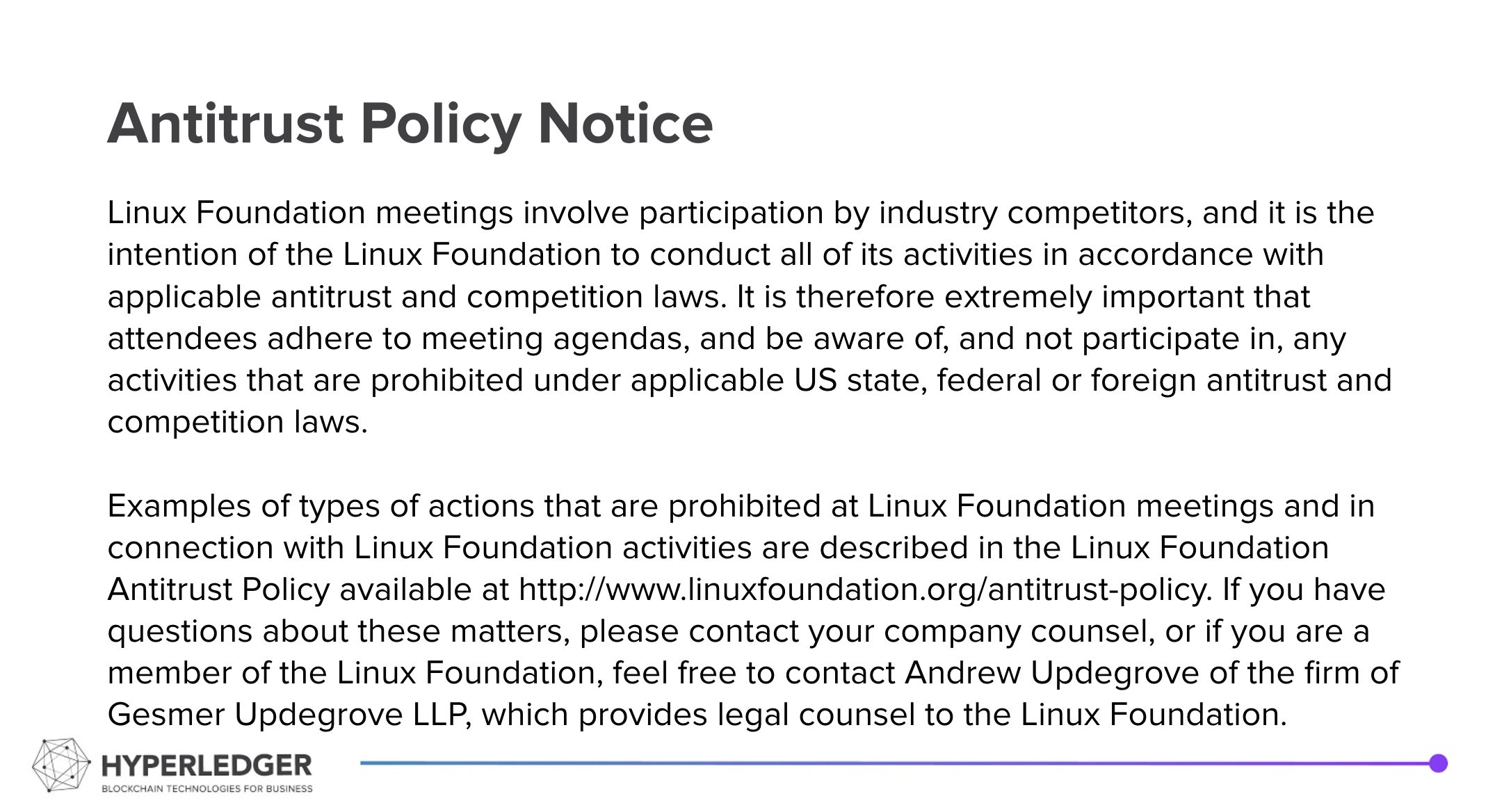- Type your task here, using "@" to assign to a user and "//" to select a due dateVipin Bharathan to update the paper, bring it into github before "11/13/2019"
- Vipin Bharathan send out github procedures for inviting maintainers.
Agenda
- Antitrust Policy and introductions - VB
- Identity WG Implementer call - report -
- Meeting Notes 2019-10-24 Identity WG Implementers Call Daniel Bluhmor Richard Esplin or anyone who was on the call
- Discuss IDWG paper & Implementor's WG
- A github repo was created under hyperledger for IDWG; Let us discuss the governance of it. This is mostly to house our paper, we will also create more outputs from our group. Ideas are welcome.
- Reframing data protection @Elizabeth Reneiris
- Report on IIW Nathan George David Huseby Daniel Hardman or anyone who was there
- ID2020: What happened and why is it important Vipin Bharathan
- Kiva - current status. After the UNGA- any one from Kiva (Matt Raffel or Cam Parra )
- Implementing metrics from Chaoss... DCIWG- let us discuss.
- Progress of Identity Working Group paper. Further comments by Brent Zundel
- Aadhaar section-look at reworked areas
- Paper collaboration - Marta Piekarska, Kelly Cooper, Sze Wong
- A talk by Kim Cameron in the offing.
...
| dlt.nyc | vip@dlt.nyc | |
| Kelly Cooper | Independent | kellycooper.2ds@gmail.com |
| Ajay Jadhav | AyanWorks | ajay@ayanworks.com |
| Gowri | ||
| Marvin Berstecher | esatus AG | m.berstecher@esatus.com |
| Nitin | gio | |
| Santanu Mukherjee | ||
| Sumit Kumar | Cap gemini | |
| Todd Gehrke | Luxoft | |
| Kaliya Young |
...
- Complexity of problem that needs to be solved in India because of mix of people
- Santanu brings in the problem of illiterate people to buttress this argument- Vipin says it is the edge interaction that can make this bad, since the middlemen disrespect and mistreat the poor users.
- Aadhaar is extremely useful due to its use in widescale Aadhaar is extremely useful due to its use in widescale PDS (public delivery system) for food, cuts out middlemen, fraud- Upheld by the supreme court of India
- Kaliya, Vipin and others concur.
Kaliya
- Aadhar as a model was written many years ago, but we need to move towards a model which is more decentralized; this is where verifiable credentials come in
- Verifiable credentials WG in W3C is defining the standards around creation of credentials, any authority can create credentials with cryptographic proofs that can reside in the users digital wallet and can be shown to relying parties without involving the issuers
A frame may be to talk about the centralized systems and to not frame it as 'there's an issue with centralized identity models, state-issued or commercial'. This is what's happening in the world today, either one isn't great. They're not good for people that there's a limited choice in who I trust to manage my identity.
Vipin
- The VC standard is a meta standard; fixing language, format etc. allowing for programs to make sense of data in credential issued by anyone
- How do we go from here to there (i.e. from centralized systems that leak data ("phone home") to decentralization, what is the path for adoption?
- Are there systems at scale for SSI
Nitin:
- Aadhaar does not track use case, it is a log; it used to track location of edge device, now that is not being tracked as well. Some changes for the better.
Ajay
- AyanWorks created a usecase where an offline Aadhaar XML file can be downloaded in the mobile app using a standard OTP Authentication process, and based on the attributes in the XML file, the App creates a self-attested Verifiable Credentials (VC) which could be presented as a cryptographic proof of Aadhaar derived Identity. The relying party (verifier) can very well verify whether this Aadhaar derived VC is really issued by UIDAI or not.
Given Below is the unedited Given Below is the unedited transcript and free form text of the call created by Kelly in realtime:
Kaliya: Need to separate out some concerns. One is it's widely accepted practice for local authorities to issue birth certificates, and that ends up being the basis for other documents states issue to citizens, such as identity cards and passports. India created such an identity system. Aadhaar and Singapore systems see everywhere a person uses that identity. 'Phone home' architectures cause issues; yes there's a role for governments to authenticate things such as births. Does that mean the 'state' should be an identity provider? No, in government or with companies (Google). People should be able to act without authoritative sources knowing.
...

